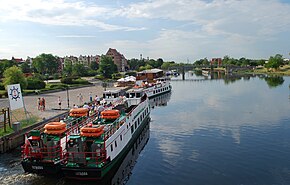Elblag harbor
| Elblag harbor | |||
|---|---|---|---|
| Data | |||
| operator | Zarząd Portu Morskiego Elbląg | ||
| Port type | seaport | ||
| Total area of the port | 470 ha | ||
| Passengers | 30,000 | ||
| website | www.port.elblag.pl | ||
| Geographic information | |||
| place | Elbląg | ||
| Voivodeship | Warmian-Masurian Voivodeship | ||
| Country | Poland | ||
| Pier for passenger ships | |||
| Coordinates | 54 ° 10 '26 " N , 19 ° 23' 14" E | ||
|
|||
The port of Elbląg ( Polish Port morski Elbląg , German Port of Elbing ) is a port in the Polish city of Elbląg ( German Elbing ). The port is located on the Elbląg River ( Elbing in German ), six kilometers from its confluence with the Fresh Lagoon ( Zalew Wiślany in Polish ). It is the largest port in the mouth of the Vistula ( Wisła in Polish ).
history
The port was officially opened as a Polish seaport in 1952. However, its story is much longer.
Due to its location on the Elbing, which is connected to the Vistula, Elbing was next to Gdansk the most important seaport for East Prussia . Shipbuilding developed in Elbing during the Prussian and German period (1772–1945) . In 1837 the Schichau-Werke was founded, which over the years developed into the largest group in East Prussia. In 1900 the company had 3,000 employees. Produced steam engines , locomotives , special, trade and warships , mostly destroyers and submarines for the Navy and for export, mainly to European countries and China, Japan, Argentina, Brazil and the United States.
The Schichau works were on the quayside, as was the Elbinger Actien brewery, founded in 1872 .
In the 1930s the importance of the Elbinger port increased. The largest turnover was recorded in 1936 - half a million tons. Coal, coke, iron, animal feed and fertilizers were exported through the port. Grain, flour, tobacco and machine components were imported. During the Second World War , submarines and torpedo boats in particular were built near Schichau. Between 1885 and 1945, 1634 ships of various types were built near Schichau.
In 1945 Elbing fell with the southern part of the former German province of East Prussia to Poland. Despite the city's attempts, the port was unable to revert to its former role as a seaport shortly after the war and in the 1960s. The Soviet agreement with Poland of 1945, which guaranteed Polish shipping through the Russian part of the Fresh Lagoon and the Pillauer Tief ( Polish : Cieśnina Piławska , Strait of Pillau ), was ignored by the Soviet side and the port was excluded from international connections.
As a result of the change in the political situation, the city took measures in the 1990s to reactivate the port of Elbląg. The port boundaries were updated and a sea border crossing was created in which all the facilities required for freight and passenger traffic are present. Freight and passenger traffic has revived since 1993.
The greatest opportunity for the development of the port lies in the construction of the canal through the Fresh Spit , which avoids shipping through the Pillauer Tief, controlled by the Russian authorities.
Technical specifications
The driving path depth is normally 2.5 meters, but only 1.8 meters in extremely dry seasons.
The length of the quay is 3.686 kilometers, 300 meters of which form a pier for passenger ships .
The port has five port basins, a repair yard, a crane with a load capacity of 150 tons, a 120 m reversible pool, a siding and all facilities required for passenger and freight traffic (border protection, customs office, harbor master's office, seaport authority, plant protection control point).
With its five marinas, it offers favorable conditions for sailing and other water sports.
The port is the starting point for shipping on the Oberland Canal .
Web links
Individual evidence
- ↑ Historia portu. In: port.elblag.pl. Retrieved March 24, 2020 (Polish).
- ↑ a b Dane ogólne. In: port.elblag.pl. Retrieved March 24, 2020 (Polish).



